Resources
Uncovering Your Content’s Hidden Insights
PART 1:
Why You Need a Digital Supply Chain
The content lifecycle isn’t a new concept for life sciences marketers. Rigorous review cycles have always been crucial for ensuring only compliant brand messages reach doctors and consumers.
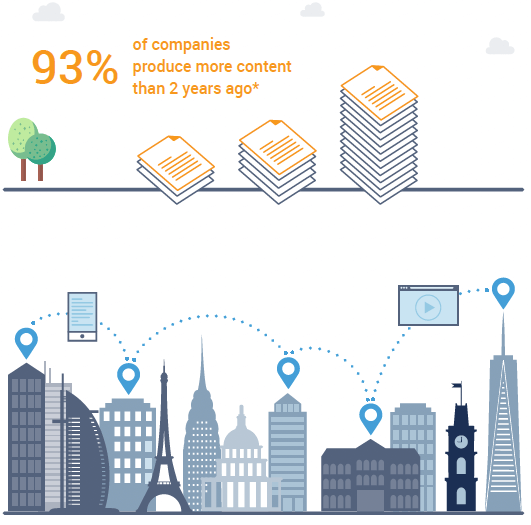
But while the core objective of this process still stands, technology is creating new possibilities. 93% of life sciences companies are developing more content than they were 2 years ago.* This influx of promotional materials is changing the healthcare marketing landscape, from the type of assets produced to the systems managing these materials.
Having a central location for assets gives global teams access to the same materials and makes it easy to share content all over the world. The cloud also enables better compliance by automating important tasks -- like linking claims to their reference documents – and providing more detailed tracking processes – like review times and reuse.
This technology-enabled content journey – the digital supply chain – is how promotional materials move through the full lifecycle. Starting with creation, review, and approval, materials then travel through different channels like web, email, and the field before ultimately arriving in the hands of doctors and consumers.
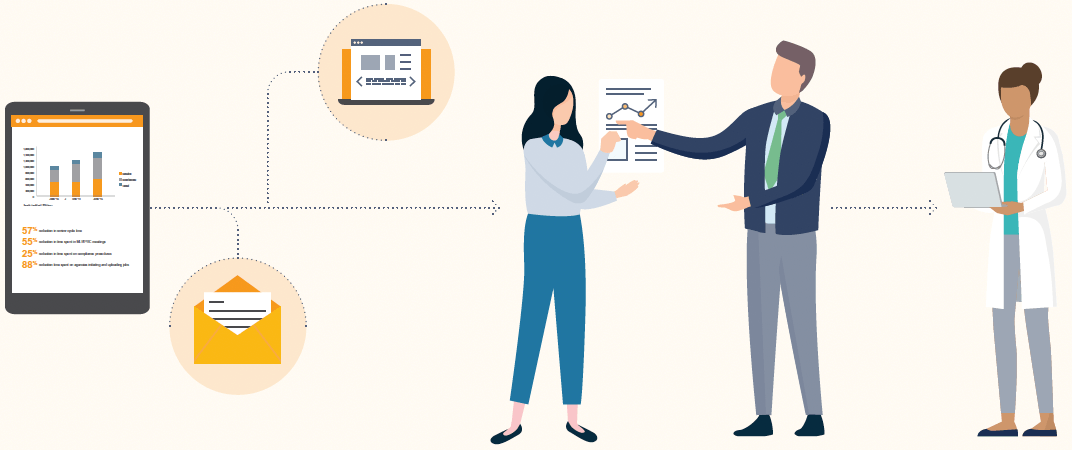
Why the Digital Supply Chain is Unique
What’s unique about the life sciences digital supply chain is the way it brings stakeholders across the content development process (marketers, ops, agencies, medical, legal, regulatory, and the field) together in a single place. This gives marketing teams a full picture of their promotional materials so they can determine how to refine their strategy and produce more valuable assets, faster.
Digital Supply Chain Components
But before diving deep into how to measure content to produce more personalized materials, it’s important to understand the components of the digital supply chain:
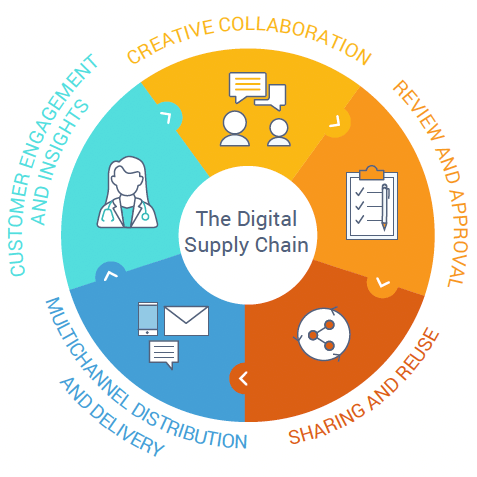
Creative collaboration
Like the traditional content journey, the digital supply chain begins with creative collaboration. This can take many forms - collaboration across your marketing team, with agencies, or even between regions.
Whether you produce content in-house or partner with external vendors, creating compelling, brand-aligned content sets the digital supply chain in motion.
Review and approval
Next is review and approval. Companies call this process different things: MLR, LMR, PLC, POP, etc. Regardless of the acronym, the goal is the same: get the necessary stakeholders to review and approve content quickly so it’s compliant and ready for distribution.
Bringing together three different teams on one workflow is complex. But managing these cycles through the cloud has simplified this process now that each group accesses assets on the same central system.
Content sharing and reuse
After content is approved, it’s time to spread the word to your colleagues. There are many ways to share content – here are some common examples:
- With other regions: save your global teams the hassle of recreating existing assets from scratch. Let them know when materials are ready, so they can localize or modify them for their needs.
- With other brand teams: keep other brands informed of your latest assets. They may find inspiration from your content or uncover messages and materials that also apply to their audiences.
- With the field: share materials - like detail aids and iPad presentations - with your reps to ensure they’re using the most recent, approved assets.
Multichannel distribution and delivery
Armed with approved content, your teams are ready to share messages with the market. Companies can use a variety of different channels depending on their audiences’ preferences:
- In-person
- Web social media
- Marketing newsletters
- Webinars
- Events
Customer engagement and insights
Getting your content in the hands of the customer is a great milestone. But it’s not the final step. It’s also important to know if materials resonate with your audience, whether that’s patients on your website or doctors in an office.
You can measure customer reaction to and engagement with assets using tools like tracking links, social metrics, and content sentiment, all of which should flow back into the centralized system. It’s also a good idea to ask for feedback directly - especially if you’re meeting with customers in person.
Once you gather data on asset performance, you can see your results and use these findings to adjust your marketing strategy.
PART 2:
Measuring Content Performance
Each step of the digital supply chain can offer endless insights for improving your content program – as long as you’re asking the right questions at the right stage. Getting granular with your analysis is the best way to learn which metrics fit your goals.
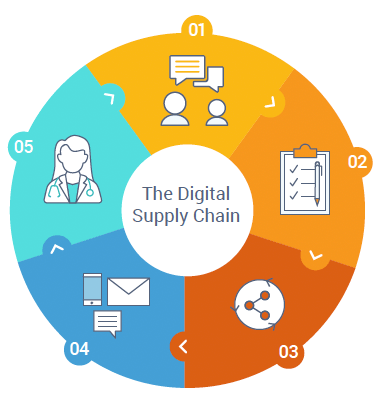
01 CREATIVE COLLABORATION
Goal: determine the best way to produce valuable content- How much do different content types cost to produce?
- How many iterations do we go through before submitting content for review?
- Does working with an agency speed or slow content development?
02 REVIEW AND APPROVAL
Goal: get content approved quickly while ensuring compliance- How much time do MLR teams spend reviewing content?
- How much extra money does it cost per day in MLR review?
- How many review cycles does content go through?
03 CONTENT SHARING AND REUSE
Goal: drive global content reuse to avoid duplicating efforts- What percentage of content is reused, and by which region?
- What are the different ways we’re sharing content? Global-to-local? Local-to-local? Cross-brand?
- How much money do we save by reusing content?*
04 MULTICHANNEL DISTRIBUTION AND CONTENT DELIVERY
Goal: understand how content is performing in each channel- How much content is being used?
- Is this channel the best way to deliver that type of content?
- How current is this piece of content and its messaging?
05 CUSTOMER ENGAGEMENT AND INSIGHTS
Goal: create more valuable content- Is our intended audience consuming our content?
- What are our top-performing pieces? Our lowest-performing pieces?
- Based on usage, should we reapprove this content?
Identifying questions by stage is important for analyzing each step in isolation. But understanding how these categories interact uncovers the deeper story of how well your content strategy fulfills your content goals.
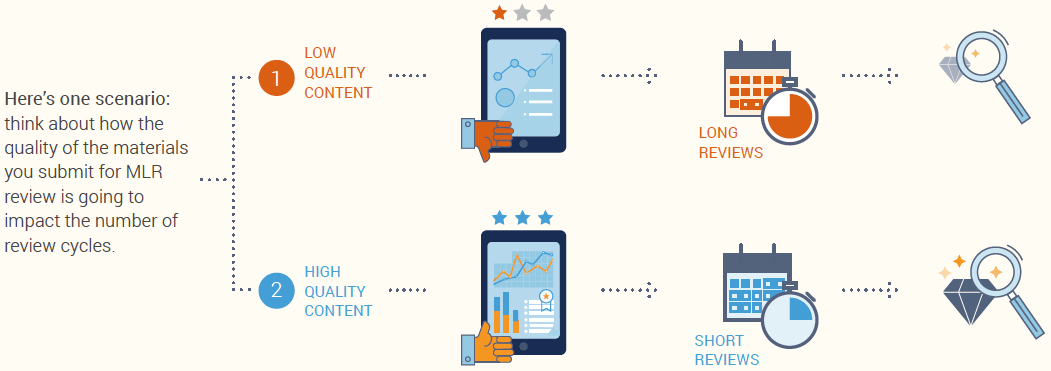
The lower the quality, the longer it will take. And more time in review means expensive resources like legal and regulatory are spending valuable hours on just one asset.
It also means that materials won’t get to market as quickly. This can affect how many reps or regional marketing teams use and reuse the materials. If they have to wait months after a piece of content was promised, they may find other assets to promote in the meantime or produce it themselves.
Which leads to the one question all teams have in the back of their minds: was developing this asset worth its overall cost?
Of course, answering this question requires more than just one metric. When you look at the entire content journey you can pinpoint what’s working well and what needs fixing.
PART 3:
Uncovering Your Content’s Hidden Insights
Just as there are many ways to ask questions, there are many ways to combine metrics to get the full picture of your content performance.
To avoid getting overwhelmed by the possibilities, consider two crucial factors:
- What is the one aspect of our content program that we’re trying to improve (overall goal)?
- Which metrics are necessary for analyzing this overall goal?
Identify a goal that’s simple, straightforward, and measurable. For example:
- Get materials to market faster
- Drive greater reuse across global teams
- Reduce our reliance on agency support
- Save money
- Provide more valuable content to our customers
You can then begin to chart how to measure progress.
Let’s say your organization wants to drive greater reuse across the globe. The home office is concerned that regional teams are recreating existing materials. Take a look at how to uncover bottlenecks:

Set the foundation
Start with core metrics around review speed by tracking how long it takes for content to go through a typical MLR review. Measuring both global and local review times in case regional teams need to translate materials and send them through local review.
Dig deeper into reuse
Once you’ve defined an average MLR time by region, look at whether teams are actually reusing materials. Identify trends – when assets take longer to get through MLR review, do fewer groups use these materials? Or, are certain regions spending more time recreating existing content?
Measure value
Sharing approved materials with regional teams is only one side of the coin. If your audience doesn’t find your assets valuable, it doesn’t matter how high reuse is. Continue to track content once teams distribute it. Once you know which messages resonate - or fail - with your audience, you can adjust your marketing strategy to create more personalized assets.
Draw conclusions
Improving content reuse at your organization will likely involve more than one answer. You may need to figure out why MLR review is slow as well as improve the quality of your content. Realizing that these two pieces compose a more complete view of reuse at your organization is key to figuring out how to improve results.

FINAL CONSIDERATIONS
Evolving Your Digital Supply Chain
Driving a successful end-to-end content program requires more than just identifying the right metrics. Teams need to be bought into the digital supply chain vision as well as understand the unique, important role they play. Keeping everyone informed of your goals - whether it’s increasing reuse or cutting costs - will empower them to offer valuable feedback on how to improve processes. Like any successful strategy, a well-oiled digital supply chain must consistently evolve to meet the changing needs and goals of your organization.